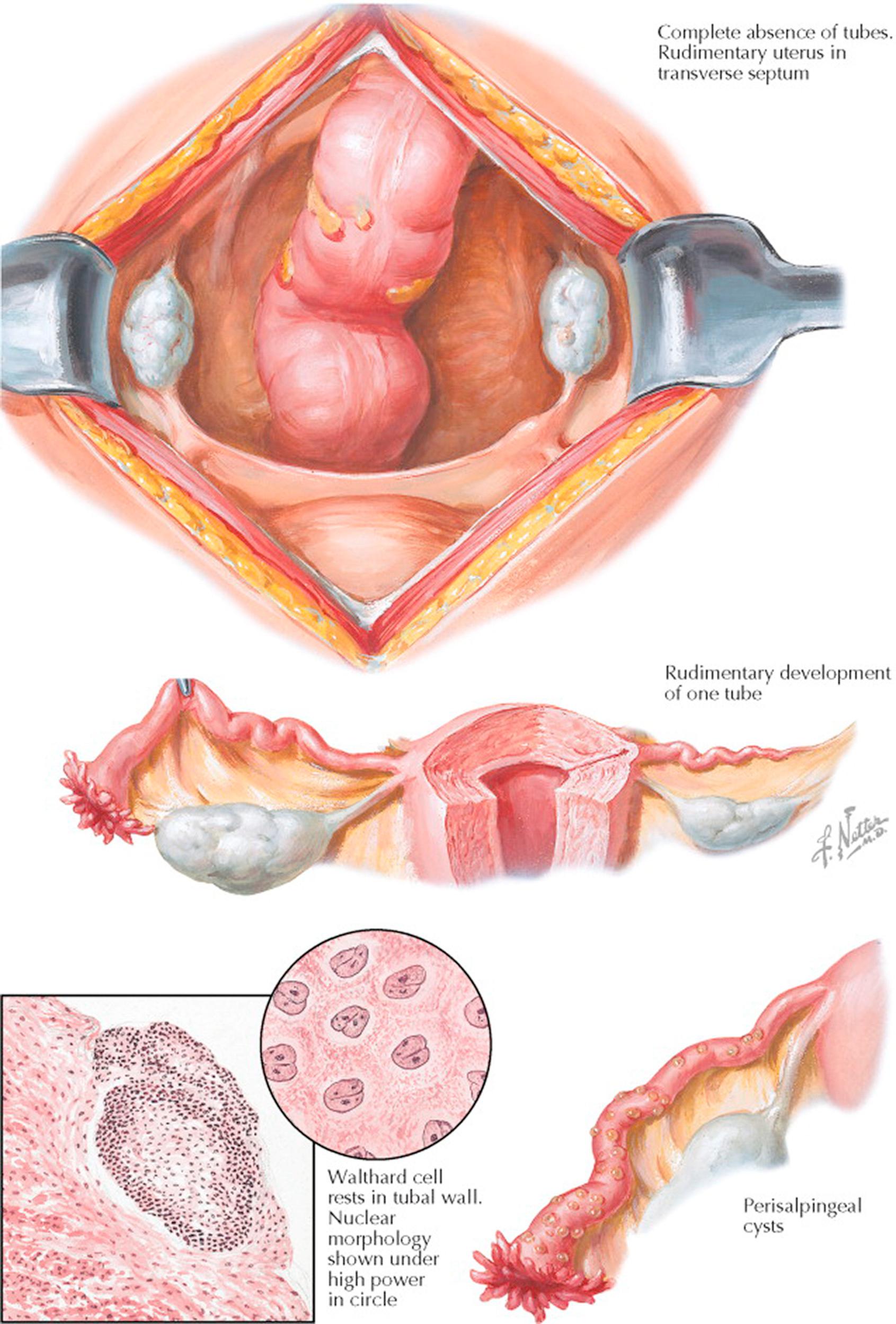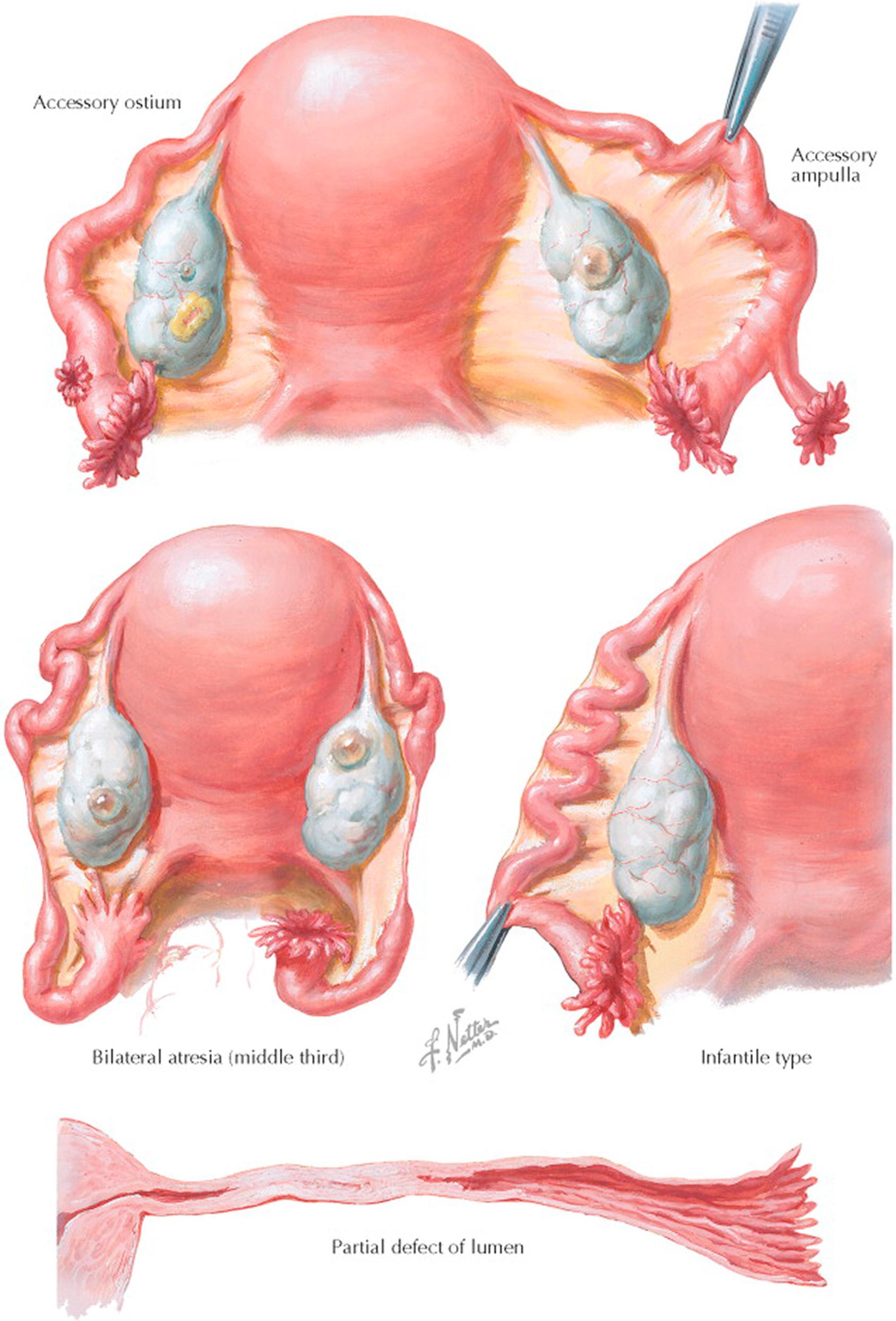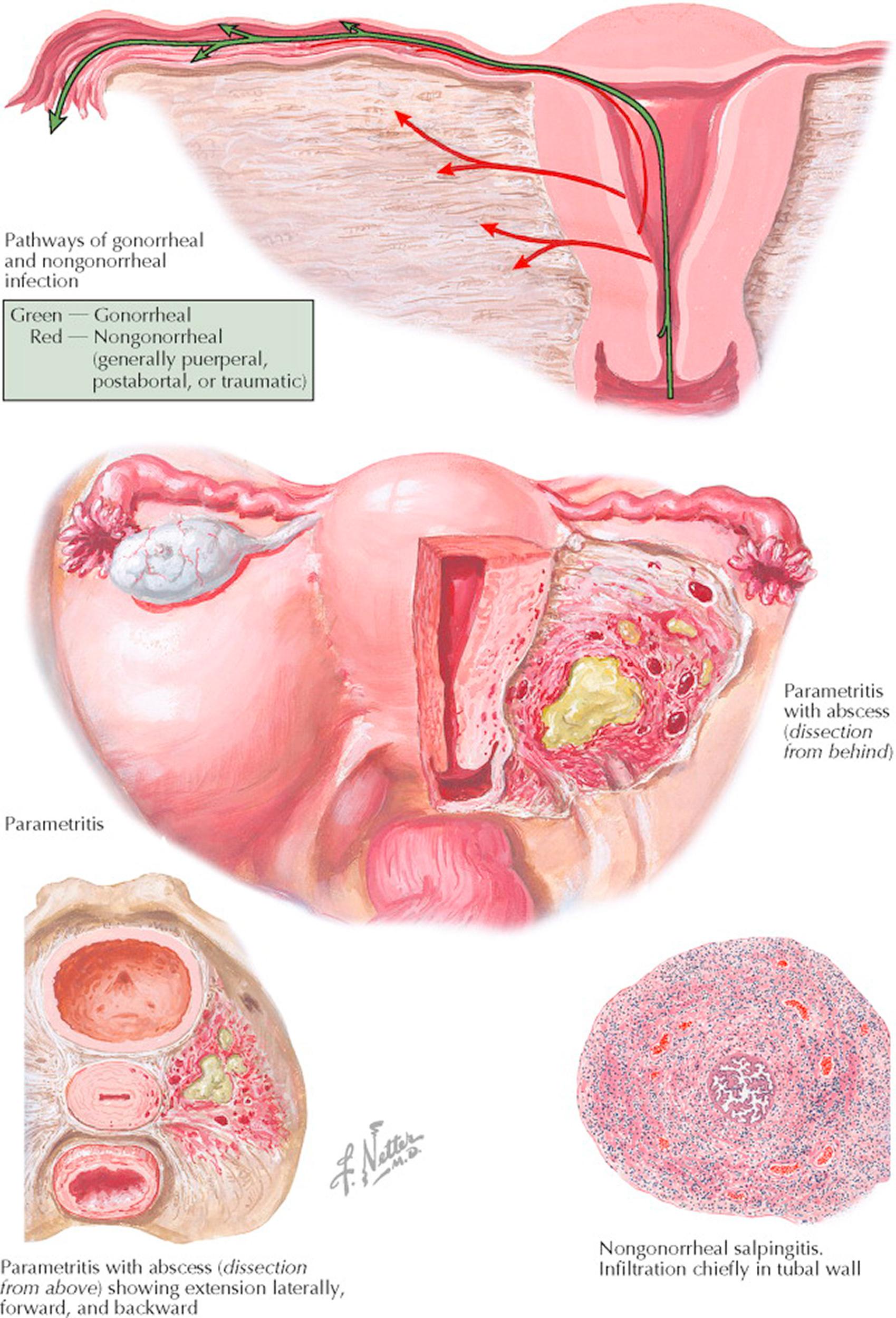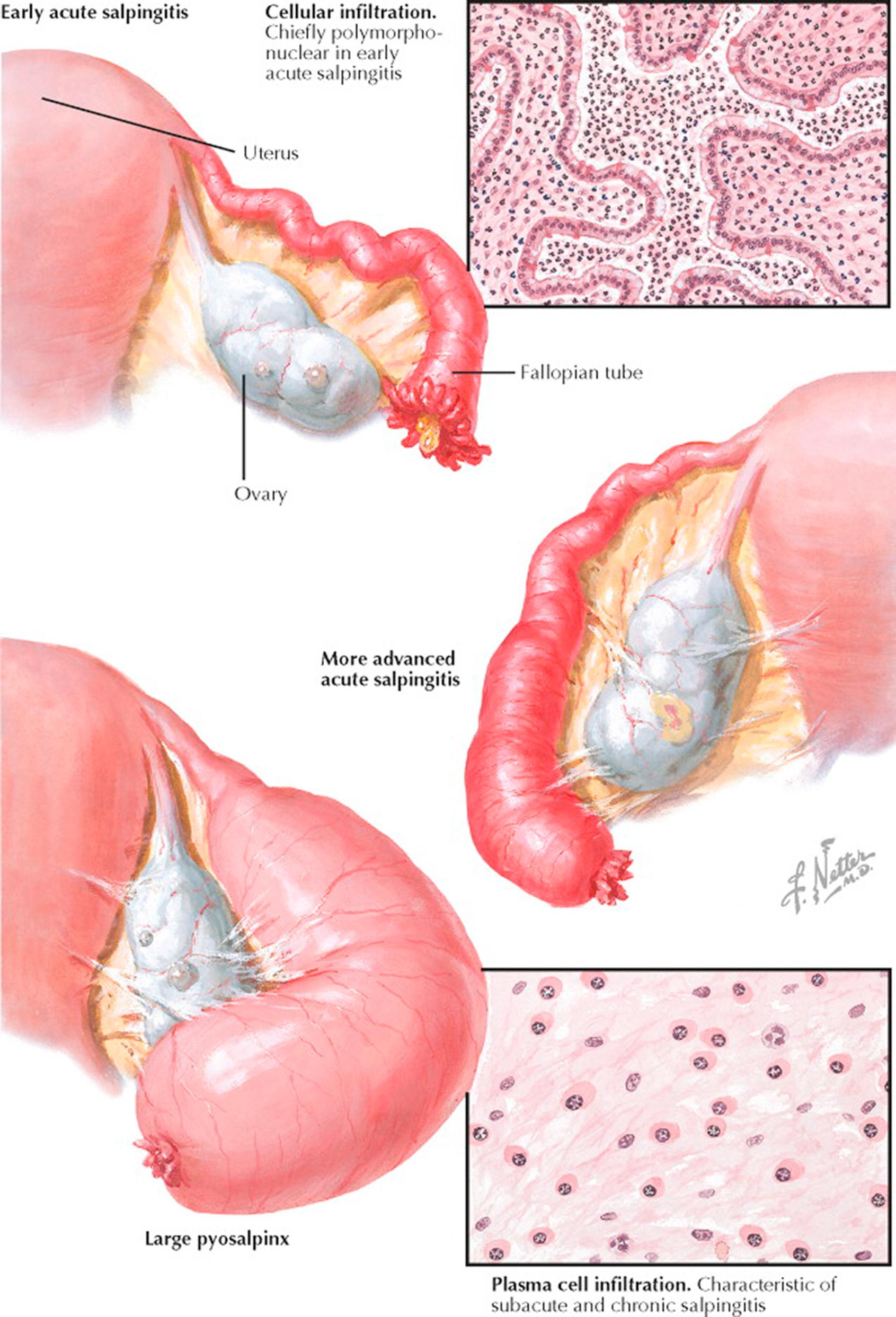Physical Address
304 North Cardinal St.
Dorchester Center, MA 02124
The fallopian tubes are musculomembranous structures, each about 12 cm in length, commonly divided into the intramural, isthmic, and ampullary sections.
The intramural (interstitial) portion traverses the uterine wall in a more or less straight fashion. It has an ampulla-like dilation just before it communicates with the uterine cavity. On hysterosalpingography, this tiny tubal antrum either is connected with the shadow of the uterine cavity by a threadlike communication or is separated from it by a narrow, empty zone. This constriction of the tubal shadow, usually designated as the tubal sphincter, is caused by an annular fold of the uterine mucosa at the junction of both organs.
The isthmic portion is not quite so narrow as the intramural part. Its course is slightly wavy. The ampullary portion is tortuous and gradually widens toward its outer end. It terminates in a fimbriated infundibulum, which resembles a ruffled petunia or sea anemone. One of the fimbriae, the fimbria ovarica, is grooved and runs along the lateral border of the mesosalpinx to the ovary. Frequently, one or more small vesicles filled with clear, serous fluid, called appendices vesiculosae or hydatids of Morgagni, are attached to the fringes of the tube by a thin pedicle. They are remnants of mesonephric tubules.
The wall of the tube consists of three layers—a serosal coat, a muscular layer, and a mucosal lining. The tunica muscularis is composed of an inner circular and an outer longitudinal layer of smooth muscle fibers. The interstitial portion is equipped with an additional, innermost, longitudinal muscle layer. The muscular coat is thicker in the medial section than in the ampullary portion, where the longitudinal muscle bundles are more widely separated. Contraction of the longitudinal muscle fibers of the ovarian fimbria brings the infundibulum in close contact with the surface of the ovary.
The abundant blood supply of the tubes is derived from the ovarian and uterine blood vessels. The blood vessels are strikingly abundant, particularly in the infundibulum and the fimbriae, where they form with interspersed muscle bundles a kind of erectile tissue, which, if engorged, enables the tube to sweep over the surface of the ovary.
The mucosa (endosalpinx) is thrown into longitudinal folds that are sparse, low, and broad in the inner portions but numerous, branched, and slender in the ampullary portion. The simple mucosal arrangement of the inner sections contrasts strikingly with the complicated, labyrinth-like appearance of the arborescent mucosa in the ampulla.
The mucosa rests on a thin basement membrane, is connected with the muscularis by a thin layer of loose, vascular connective tissue, and can undergo moderate decidual reaction if a fertilized ovum becomes implanted in the tube.
The mucosa consists of a single layer of columnar cells, some of which are ciliated, whereas others are secretory. A third group of peg-shaped cells with dark nuclei is intercalated between the ciliated and secretory cells and represents apparently worn-out cells, which are gradually cast out into the lumen of the tube. The numerical relationship between ciliated and secretory cells changes during the menstrual cycle. The number of secretory cells that secrete nutrient material to sustain the ovum during its stay in the tube is greater in the luteal phase. The height of the tubal epithelium reaches its peak during the period of ovulation and is lowest during menstruation.
The motion of the tubal cilia is directed toward the uterus, causing a current that can sweep small particles into the uterus, but peristaltic action and not the ciliary motion drives the ovum toward the uterus.

The fallopian tubes arise from the unfused cranial portions of the müllerian (paramesonephric) ducts. The origin of these ducts is first indicated in embryos of 8.5 to 10 mm by grooves in the thickened epithelium of the urogenital ridge lateral to the wolffian ducts, which were formed in an earlier stage of development. Soon these grooves become deeper and advance caudad as tubes until they meet the epithelium of the urogenital sinus in a prominence, the müllerian tubercle.
The development and growth of the müllerian ducts depend on the presence of the wolffian ducts. As a rule, the müllerian duct fails to develop when the ipsilateral wolffian duct is lacking. In the absence of müllerian inhibiting factor made by the Sertoli cells of the developing testes, the mesonephric ducts regress, and the paramesonephric ducts develop into the female genital tract. The more cephalad portions of the paramesonephric ducts, which open directly into the peritoneal cavity, form the fallopian tubes.
The paramesonephric ducts, and similarly the wolffian duct, grow more slowly than the fetal trunk as a whole. As a result, the location of the coelomic ostia of the ducts gradually slides caudally to the fourth lumbar segment. Originally, the urogenital fold, which contains the mesonephros and the wolffian and müllerian ducts, has a sagittal course parallel to the spine. The development and growth of the adrenals and kidneys cephalad to these structures change the direction of the urogenital fold, bending it laterally in its upper section. With progressive descent of the ovary and the fallopian tube, the direction of the tube becomes more transverse, whereas the lower parts of the müllerian ducts, which give rise to the uterus, retain their original longitudinal course and fuse in the midline.
The muscular and connective tissues of the tubes are first apparent in the third month of fetal life and may be clearly demonstrated in the fifth month. However, the ampullary portion does not take on its characteristic appearance until the last month of gestation.
Congenital anomalies of the fallopian tubes may be due to developmental error or injury, such as torsion or inflammation. Complete absence of both tubes is sometimes observed in combination with aplasia of the uterus. In such cases, a transverse pelvic septum, corresponding to the broad ligament, connects the ovaries and may contain muscular nodules in the lateral sections of its upper margin that represent rudiments of the müllerian ducts. The round ligaments, which have a separate origin, may be well developed. In these cases aplasia of the vagina is common but not the rule.
Absence of the ampullary portion of the tube is probably caused by twisting and subsequent necrosis with resorption of the ampullary portion of the tube rather than a result of developmental failure. A congenital defect of the wolffian duct is, as a rule, followed by a defect of the homolateral müllerian duct. The resulting anomaly is characterized by the absence of the fallopian tube, the uterine horn, the kidney, and the ureter.
Small, solid, or cystic nodules of a type first described by Walthard and thus called “Walthard cell rests” are commonly found in the subserosal tissue of the fallopian tube. The nuclei of these Walthard cells show a median groove or fold, which is a fundamental characteristic of these cells.
Frequently found on the surface of otherwise normal fallopian tubes are tiny multiple serosal (perisalpingeal) cysts. They apparently originate from an invagination and occlusion of the serosal epithelium and do not have any practical significance. The supposition of some authors that these cysts are caused by chronic inflammation is not generally accepted.

Unilateral complete or partial defects of one müllerian duct are more common than aplasia of both ducts. Many variations of this anomaly are encountered, such as uterus unicornis, with or without rudimentary contralateral horn; unilateral atresia; or total, partial, or regional defect of the fallopian tube. The genesis of partial defects of the fallopian tubes is very hard to explain. But the same holds true for similar congenital defects occurring in other hollow organs, for example, the esophagus, the small intestine, and the vas deferens. The nature of the temporarily inhibiting factor responsible for the defects in the lumen or the continuity of these organs is unknown, and all attempts to explain these lesions have failed hitherto.
More frequent than defects due to inadequate tubal development are excess anomalies such as accessory tubal ostia, accessory tubes, and supernumerary tubes. Nevertheless, a supernumerary tube (tuba supernumeraria or tertia) is a great rarity. Such a tube runs parallel to the main tube and has the same structure. It can occur with or without a supernumerary ovary.
In contrast to the rarity of supernumerary tubes, accessory tubes and accessory tubal ostia are very frequent. The accessory tubes arise either from the main tube or from the mesosalpinx and consist of a more or less well-developed wreath of fimbriae with a pedicle, which is usually thin and may be either hollow or solid. Even if hollow, it does not communicate with the cavity of the main tube. If the lumen of the accessory tube is closed at both ends, it becomes transformed into a small pedunculated vesicle. Production of tubal fluids within this blind segment can result in cystic dilation, mimicking a hydrosalpinx or ovarian cyst.
Although accessory tubes may arise from any part of the ampullary portion of the tube and even from the isthmic section, accessory tubal ostia are always situated near the main ostium. The accessory ostia have the same appearance and structure as the main ostium. They always communicate with the tubal cavity. There has even been a single case report in which laparotomy demonstrated that the proximal portion of one fallopian tube was absent and that the distal end was separated into three portions.
Hypoplasia of the fallopian tube is frequently seen. The hypoplastic tube is thin and ischemic, its musculature weak, and its ampulla poorly developed. A special type, commonly designated as “infantile tube,” is characterized by tight windings that are bridged by peritoneal folds and, therefore, cannot be straightened. It may be that the peritoneal bridges between the tubal windings interfere with the tubal peristalsis in the same way as do adhesions and predispose to retention of the fertilized ovum in the tube and thereby to the occurrence of ectopic pregnancy.
In utero exposure to diethylstilbestrol (DES) has been associated with fallopian tubes notable for pinpoint ostia, constricted fimbriae, and a short or a sacculated or convoluted course. These changes may be a cause of female infertility and are generally not detected by hysterosalpingography. It has also been postulated that salpingitis isthmica nodosa may follow DES exposure during gestation.
Incomplete descent and steep course of the tube are other forms of developmental arrest. Excessive descent and dislocation of the tubes and ovaries in inguinal hernias may occasionally be seen, especially in intersexual individuals. Incomplete union of the müllerian ducts in their uterine sections and lateral flexion of the uterine horn favor the dislocation of the tube and ovary into inguinal hernias.
Conventional therapy consisted of surgical correction, where possible, but the availability and success of oocyte harvesting, in vitro fertilization, and embryo transfer have generally supplanted surgical therapy.

Inflammatory diseases are not only frequent but also potentially serious—with both immediate and long-term consequences. The tubes, which are inserted between the uterus and the ovaries, are easily infected from either of these organs. The open communication of the tube with the peritoneal cavity exposes the tube to any peritoneal infection and vice versa. Appendicitis is a frequent source of infection of the right or of both tubes; sigmoiditis or diverticulitis often migrates to the left tube. Sometimes the hematogenous route infects the tubes. This is the rule in tuberculous salpingitis.
Inflammatory disorders of the uterus frequently extend to the tubes. The ciliary current of the tube is a very weak protective apparatus, and the narrow communication between tube and uterus is an ineffective barrier. Besides, the narrow lumen proves to be a serious handicap when the tube is inflamed. Swelling of the mucous membrane may cause complete occlusion of the uterotubal junction, thereby preventing drainage of inflammatory secretions into the uterine cavity and potentially forcing infected material further toward the fimbrial end and the peritoneal cavity.
The uterus, because of its free drainage and periodic menstrual shedding, may appear healed, whereas the inflammation in the occluded tubes still persists. On the other hand, the occurrence of tubal inflammatory disease is favored by the tendency of the uterus to react to abnormal stimuli, such as bacteria or chemicals, by spasm of the internal cervical os and severe contractions, which drive these noxious agents into the tubes. Lipid imaging solutions, which are occasionally used for hysterosalpingography, may cause serious damage to the tubes.
Bacteria may invade the tubes from the uterus or from the bloodstream. The latter holds true for Mycobacterium tuberculosis , whereas gonococci, Chlamydia , and most other bacteria reach the tube by way of the mucous membranes. Gonococci settle mainly in the mucosa and have little tendency to invade deeper tissues, though they do tend to cause a transluminal inflammatory response. In contrast, chlamydial infections tend to engender a much milder but longer-lived inflammatory response, accounting for their often indolent course and greater degree of long-term tubal damage.
Streptococci and staphylococci also propagate in the mucosa but rapidly penetrate the deeper structures and invade the lymphatics and blood vessels of the uterine and tubal walls and adjacent connective tissue. The most conspicuous changes, which occur in streptococcic and staphylococcic infections, take place in the pelvic connective tissue.
The parametrial lymphatics and veins are filled with pus and partly solid, partly liquefied thrombi, whereas the surrounding tissue is distended by serous and seropurulent exudate. These changes constitute parametritis, which is mainly a lymphangitis and thrombophlebitis. Because the blood and lymph vessels are contained in the condensed zones of the pelvic connective tissue, the inflammatory infiltrate assumes the shape of these zones. It is wedge-shaped, with the base directed toward the pelvic wall and the blunt apex at the uterus. According to the arrangement of the zones of condensed connective tissue, an anterior, posterior, and median parametritis can be distinguished. In severe infections, all three zones are affected. Sometimes the purulent infection destroys the parametrial structures, causing a parametrial abscess, which may break into the zones of loose connective tissue and rapidly spread within these zones and the connected areas. The rounded shape of a large parametrial abscess can modify somewhat the wedge shape of the unliquefied, rigid parametrial infiltrate.
Risk factors for salpingitis include early (age) sexual activity and multiple sexual partners. These and related risk factors primarily affect the likelihood of acquiring gonococcal and chlamydial infections of the cervix, which, in turn, ascend into the upper genital tract, causing salpingitis. Uterine instrumentation (hysterosalpingography, intrauterine contraceptive device placement, endometrial biopsy, dilation and curettage) can also cause salpingitis but this occurs infrequently in the absence of sexually transmitted infections.

Become a Clinical Tree membership for Full access and enjoy Unlimited articles
If you are a member. Log in here